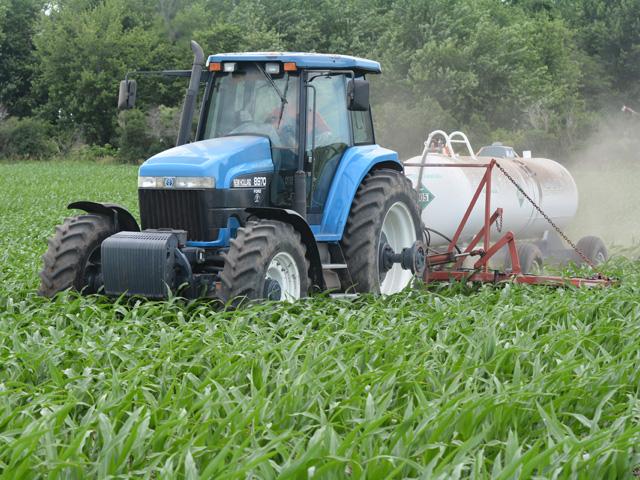N Supply, Prices Remain Unsettled
Global Issues Continue to Plague World Nitrogen Fertilizer Market
OMAHA (DTN) -- Both nitrogen price and availability remain high on farmers' and fertilizer retailers' minds as they turn their attention toward the 2023 growing season. Global events, such as the war in Ukraine and low Mississippi River levels, could have a negative effect on both price and supply in early 2023.
A recent University of Illinois Extension webinar titled "Nitrogen fertilizer decisions for 2023" featured a roundtable discussion about these issues. An Illinois farmer and a fertilizer retailer were both asked their views on various nitrogen-related topics in the hour-long dialogue.
SUPPLY ISSUES REMAIN
Joe Klein, a Champaign County, Illinois, farmer, said he does have some concerns about the supply of nitrogen come next spring. He said he hopes it is not an issue, but that it very well could be because of issues with the Mississippi River levels and the Russia-Ukraine war.
Klein said that the last couple of years have shown farmers had gotten used to calling fertilizer retailers one day and getting whatever they need right away. But supply chain issues have seeped into everyday life, affecting everything from fertilizer to toilet paper.
"It's (nitrogen fertilizer supply) not my top concern, but it's still a concern," Klein said.
Klein applies all his nitrogen in the spring, either preplant or through sidedressing. He applies about a third of his nitrogen just before planting and the remaining two-thirds through sidedressing.
Kyle Meece, agronomy manager for United Prairie located in Tolono, Illinois, said the supply of fertilizer going forward is at the top of his list. The company has learned a lot from the recent years of supply issues and hired a person whose job it is to watch the markets and make sure fertilizer is purchased at opportune times.
"Supply is always a concern for us," Meece said.
P[L1] D[0x0] M[300x250] OOP[F] ADUNIT[] T[]
One thing that goes a long way in helping a fertilizer retailer plan for future fertilizer needs is constant communication with their farmer customers, Meece said. Communicating what fertilizer is needed will help retailers plan for the 2023 growing season, he said.
N PRICES CONTINUE HIGH
The price of nitrogen continues to be a major concern for both farmers and retailers.
Klein said the volatility in the nitrogen market remains a major obstacle for those wanting to purchase fertilizer. He has taken a position to purchase some of his nitrogen fertilizer needs, he said.
Farmers should consider pricing some corn bushels as well as purchasing fertilizer, according to Gary Schnitkey, University of Illinois Extension specialist, farm management. Profits should be locked in when possible, he said.
Prices for anhydrous remain in the $1,400-per-ton range, which is up from about $1,100 per ton earlier this fall. This is also up from the $500-to-$600-per-ton price range in recent years.
DTN continues to track retail fertilizer prices weekly. The national average for anhydrous is at $1,434 per ton, while urea is at $812 per ton, UAN28 is averaging $582 per ton and UAN32 $680 per ton. See last week's retail fertilizer trends column here: https://www.dtnpf.com/….
Schnitkey said nitrogen prices could continue to be volatile in the near term.
Natural gas prices globally could continue to rise in the short term, and that could push prices higher. However, natural gas prices in the U.S. are not nearly as high, so nitrogen prices here could move lower.
"We don't really know which direction nitrogen prices will go in the coming months," Schnitkey said.
LESS FALL-APPLIED N
One general trend in the nitrogen fertilizer market in Illinois is farmers moving away from fall-applied nitrogen to applying more in spring in multiple trips across the field. This includes more sidedressing of nitrogen to get the nutrient to the corn plants as they need it.
Meece said some farmers he works with continue to apply nitrogen in the fall, which is good news for retailers, as there would be some difficulty getting all acres covered in the spring. Application in the spring allows for a couple different application times -- preplant and sidedressing -- he said.
"Agronomy wise, it is good to split up nitrogen applications and get it available at the different soils depths," Meece said.
Klein said that when he came back to his family's farming operation in 2005 after college, they would apply some nitrogen in the form of anhydrous ammonia in the fall after harvest. Over the years, they have shifted away from this practice to all of their acres being applied in the spring both in a pre-plant and a sidedressing application.
"We just felt like this was the best decision we could make to not put all of our eggs in one basket," Klein said.
Russ Quinn can be reached at Russ.Quinn@dtn.com
Follow him on Twitter @RussQuinnDTN
(c) Copyright 2022 DTN, LLC. All rights reserved.






